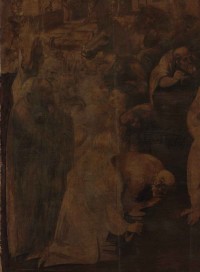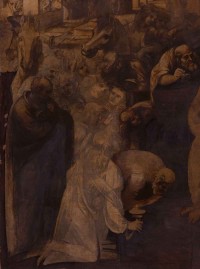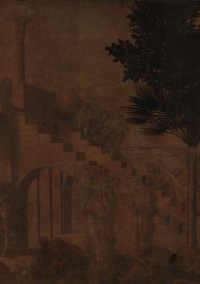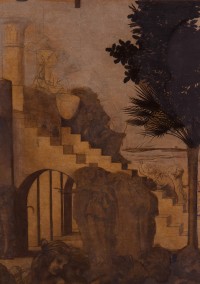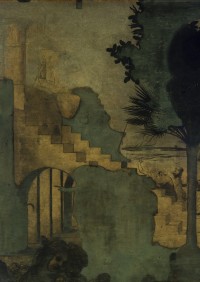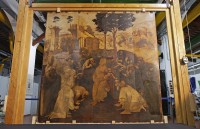 Leonardo da Vinci’s Adoration of the Magi has been in the hands of the Opificio delle Pietre Dure conservation institute in Florence since November of 2011 after Uffizi Gallery curators determined that the painting’s progressive darkening was becoming an increasingly urgent problem. After a year of preparatory work deploying a wide array of diagnostic technologies — Fourier Transform Infrared spectrometry, X-ray fluorescence, Infrared reflectography, X-Ray imaging, 3D relief for the measurement of micro deformation, Optical Coherence Tomography, chemical analysis, spectrophotometry — to analyze the paint and wood panel, conservators began cleaning the surface a year ago.
Leonardo da Vinci’s Adoration of the Magi has been in the hands of the Opificio delle Pietre Dure conservation institute in Florence since November of 2011 after Uffizi Gallery curators determined that the painting’s progressive darkening was becoming an increasingly urgent problem. After a year of preparatory work deploying a wide array of diagnostic technologies — Fourier Transform Infrared spectrometry, X-ray fluorescence, Infrared reflectography, X-Ray imaging, 3D relief for the measurement of micro deformation, Optical Coherence Tomography, chemical analysis, spectrophotometry — to analyze the paint and wood panel, conservators began cleaning the surface a year ago.
The oil on panel painting was commissioned in March 1481 by the Augustinian monks of the monastery of San Donato in Scopeto, but Leonardo, who was then a youth of 29 just starting his career, sought greener pastures with Ludovico Sforza, Duke of Milan, and the next year moved to Milan leaving the Adoration of the Magi incomplete.
The painting on wood, measuring about 2.5 by 2.5 metres (8.2 by 8.2 feet) depicts the three wise men who paid tribute to the infant Jesus in Bethlehem, but it also includes a riot of human figures, battling horses, architectural designs, landscapes and skies.
Done on 10 slabs of wood glued together, it has blank areas, areas with under-drawings, and sections in advanced stages.
“This is perhaps the most quintessential work-in-progress in the history of art,” said Cecilia Frosinini, one of the directors of the ongoing restoration of the work, which is slated to return to Florence’s Uffizi Gallery next year.
“Leonardo never wanted this to be seen by anyone at this stage, probably not even by those who commissioned it, probably not even his assistants. This is the phase in which he was still elaborating in his mind what the final work would look like,” she said, standing in front of the piece.
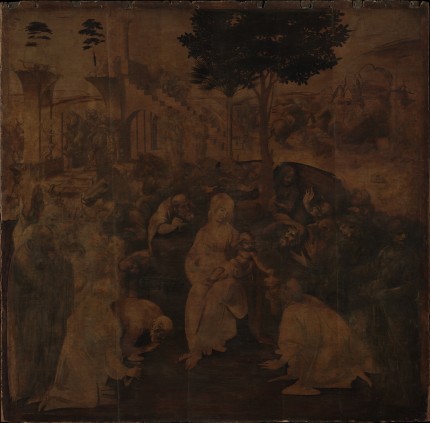
The monks eventually turned to Filippino Lippi who completed his Adoration of the Magi in 1496, and Leonardo’s piece wound up in the collection of the de Medici family 100 years later. The Medici restorers filled in paint and added layers of clear and brown varnish to give it a more finished, monochromatic look.
In addition to the accumulation of dirt, smoke and pollutants, the Opificio curators had to deal with all those past restorations. The paint and varnishes have changed over the centuries, oxidizing, discoloring, sometimes separating, sometimes adhering to the original surface and blending into it, so conservators had to be very selective in deciding what to remove. The bottom layer of varnish, for example, could be kept as a fixative and a patina, so there was no danger of damaging the original paint. Their goal was not to return the painting to original condition which simply cannot be done, but to restore its readability and brightness in a way that respects the passage of time while ensuring the most authentic and stable possible result.
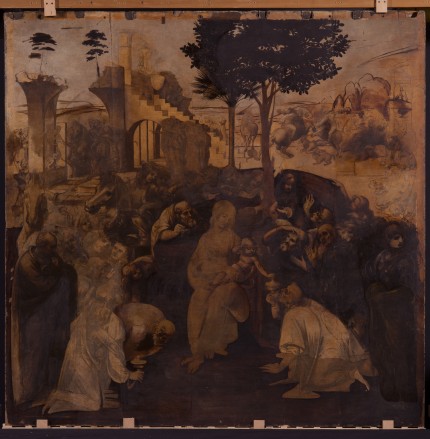
 The cleaning phase is almost done now (about three quarters of the painting has been cleaned) and it has brought to light much of the expressiveness of Leonardo’s faces, color details like the blue of the sky, design elements like the volume of the clothing and figures previously invisible to the naked eye. You can now see builders working on the ancient temple in the left background, and even subtle sketched details. One of the horses on the right has several heads in different positions, while other horses have an extra leg, evidence that Leonardo wasn’t working from a perforated cartoon outline, but rather drawing freehand as he painted.
The cleaning phase is almost done now (about three quarters of the painting has been cleaned) and it has brought to light much of the expressiveness of Leonardo’s faces, color details like the blue of the sky, design elements like the volume of the clothing and figures previously invisible to the naked eye. You can now see builders working on the ancient temple in the left background, and even subtle sketched details. One of the horses on the right has several heads in different positions, while other horses have an extra leg, evidence that Leonardo wasn’t working from a perforated cartoon outline, but rather drawing freehand as he painted.

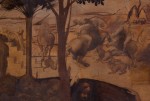
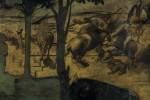
The cleaning is expected to be finished in 2015, after which the team will turn their attentions to the wood panels. There are four major vertical cracks that need to be fixed to restore structural integrity to the fragile work. The total cost of the four-year process is expected to be €170,000 ($218,000), which will funded by the Friends of the Uffizi Gallery. Once restoration is complete (hopefully by the end of 2015), the Adoration of the Magi will return to the Uffizi Gallery where it will be on display in a special room along with two other works by Leonardo.
